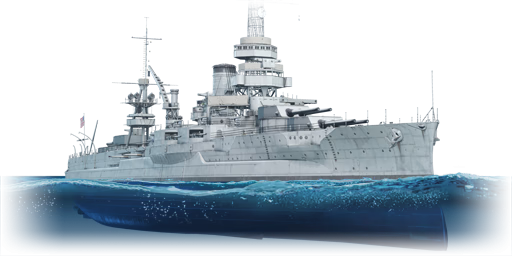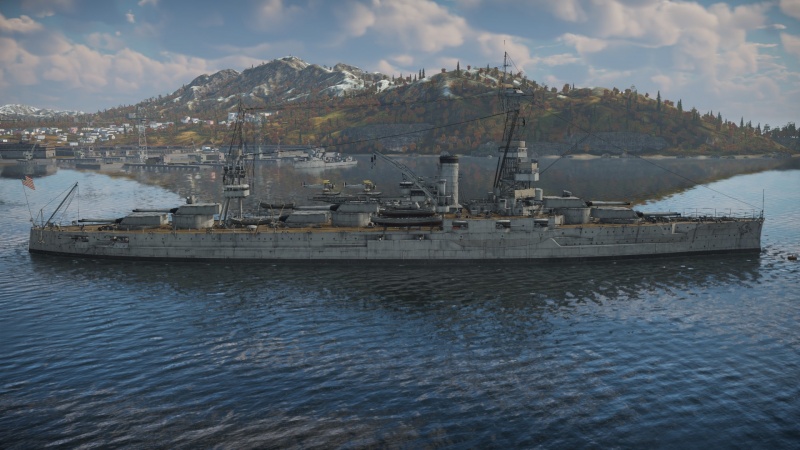USS Wyoming
Contents
Description
The Wyoming-class, USS Wyoming (BB-32), 1927 is a rank V American battleship with a battle rating of 6.7 (AB/RB/SB). It was introduced in Update "Red Skies".
General info
Survivability and armour
Talk about the vehicle's armour. Note the most well-defended and most vulnerable zones, e.g. the ammo magazine. Evaluate the composition of components and assemblies responsible for movement and manoeuvrability. Evaluate the survivability of the primary and secondary armaments separately. Don't forget to mention the size of the crew, which plays an important role in fleet mechanics. Save tips on preserving survivability for the "Usage in battles" section. If necessary, use a graphical template to show the most well-protected or most vulnerable points in the armour.
Mobility
Write about the ship's mobility. Evaluate its power and manoeuvrability, rudder rerouting speed, stopping speed at full tilt, with its maximum forward and reverse speed.
| Mobility Characteristics | |||
|---|---|---|---|
| Game Mode | Upgrade Status | Maximum Speed (km/h) | |
| Forward | Reverse | ||
| AB | |||
| Upgraded | 45 | 13 | |
| RB/SB | |||
| Upgraded | 39 | 11 | |
Modifications and economy
Armament
Primary armament
Provide information about the characteristics of the primary armament. Evaluate their efficacy in battle based on their reload speed, ballistics and the capacity of their shells. Add a link to the main article about the weapon: {{main|Weapon name (calibre)}}. Broadly describe the ammunition available for the primary armament, and provide recommendations on how to use it and which ammunition to choose.
Secondary armament
Some ships are fitted with weapons of various calibres. Secondary armaments are defined as weapons chosen with the control Select secondary weapon. Evaluate the secondary armaments and give advice on how to use them. Describe the ammunition available for the secondary armament. Provide recommendations on how to use them and which ammunition to choose. Remember that any anti-air armament, even heavy calibre weapons, belong in the next section. If there is no secondary armament, remove this section.
Anti-aircraft armament
An important part of the ship's armament responsible for air defence. Anti-aircraft armament is defined by the weapon chosen with the control Select anti-aircraft weapons. Talk about the ship's anti-air cannons and machine guns, the number of guns and their positions, their effective range, and about their overall effectiveness – including against surface targets. If there are no anti-aircraft armaments, remove this section.
Usage in battles
Describe the technique of using this ship, the characteristics of her use in a team and tips on strategy. Abstain from writing an entire guide – don't try to provide a single point of view, but give the reader food for thought. Talk about the most dangerous opponents for this vehicle and provide recommendations on fighting them. If necessary, note the specifics of playing with this vehicle in various modes (AB, RB, SB).
Pros and cons
Pros:
- Impressive main battery
- Great secondary armament
- Armour is effective against guns of calibre 203 mm and lower at range
Cons:
- Large target
- Terrible mobility
- Lacks coal bunkers
- Mediocre AA capability
- Long reload time
History
During the first decade of the post-war era, Wyoming took part in the regular operations of the U.S. Navy's battleship fleet. She was in the Atlantic area until mid-1919, then went to the Pacific, where she remained for two years. In July 1920, she received the designation BB-32 and in early 1921 cruised south to visit Chile. She returned to the Atlantic in August 1921, but periodically transited the Panama Canal for Pacicific ocean exercises. Wyoming steamed to Europe on a midshipmen cruise in the summer of 1924. In 1927, she was modernized, exchanging her coal-fired boilers for new oil-burning types, losing her after "basket" mast and receiving improvements to protection, armament and machinery.
Under the terms of the 1930 London Treaty, Wyoming was "demilitarized" in early 1931, becoming a training ship, with the new hull number AG-17. With half of her twelve-inch guns removed, she served in that function for the rest of the decade, and beyond, making midshipmen cruises across the Atlantic on several occasions. She also took part in a number of amphibious landing exercises, providing experience that would be vital to the Navy and Marine Corps during the 1940s.
In November 1941, with formal U.S. participation in the Second World War clearly in the offing, Wyoming took on the mission of training thousands of sailors in the art and science of gunnery. Throughout the war, she operated in the Chesapeake Bay area, reportedly firing off more ammunition than any other U.S. Navy ship. Wyoming's remaining big guns were replaced with more five-inch and smaller weapons in early 1944, reflecting an increasing emphasis on anti-aircraft requirements. In July 1945 she became an experimental gunnery ship with what soon became the Operational Development Force, serving in that capacity until August 1947, when she decommissioned and handed the function over to USS Mississippi (AG-128). USS Wyoming was sold for scrapping in October 1947
Media
- Skins
See also
Links to articles on the War Thunder Wiki that you think will be useful for the reader, for example:
- reference to the series of the ship;
- links to approximate analogues of other nations and research trees.
External links
- [Devblog] USS Wyoming (BB-32): high calibre romance
- https://www.history.navy.mil/our-collections/photography/us-navy-ships/battleships/wyoming-bb-32.html
| USA battleships | |
|---|---|
| Delaware-class | USS North Dakota |
| Wyoming-class | USS Wyoming · USS Arkansas |
| New York-class | USS Texas |
| Nevada-class | USS Nevada |
| Pennsylvania-class | USS Arizona |
| New Mexico-class | USS Mississippi |
| Tennessee-class | USS Tennessee |





